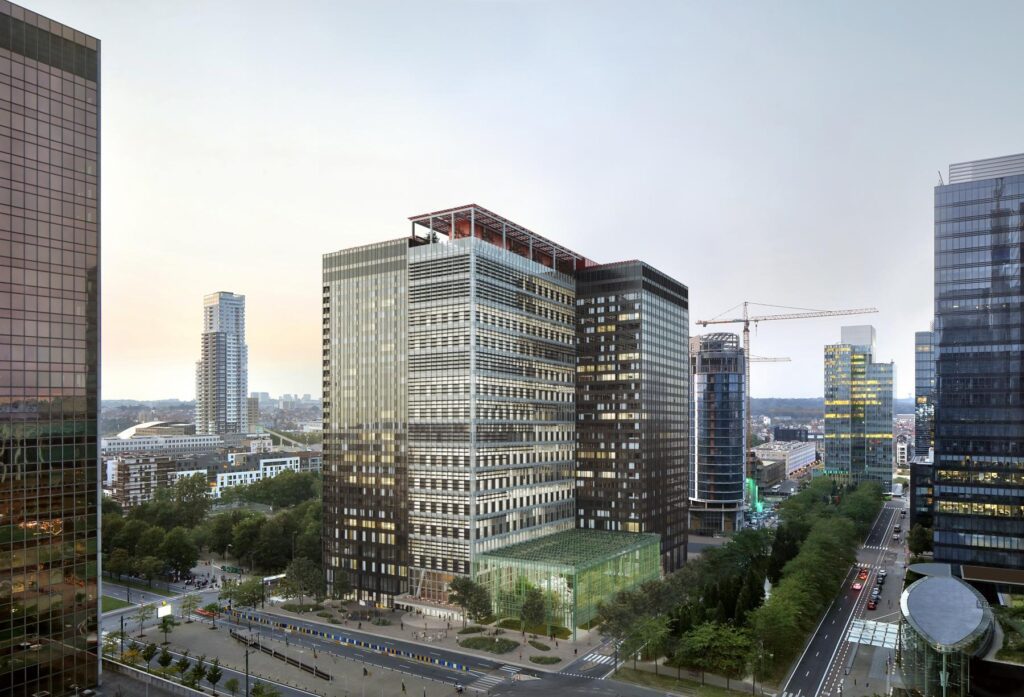Chosen by the board of directors in 2022, the “Stadsatelier de Ville” project was given a 30-year concession at the Port of Brussels. Founders of that temporary association, active in the circular economy, are BC Materials and Herk&Red.
BC Materials processes excavated soil from construction sites into building materials and Herk&Red, an investment company of Democo, also has a division around the reuse of building materials for new construction projects in Brussels.
Stadsatelier de Ville aims to be a circular hub for building materials, focusing on production, distribution, training and innovation. Stadsatelier de Ville will also rent spaces and stimulate collaboration on the site with other partners from the circular economy. Sonian Wood Coop, for example, which processes wood from the Sonian forest, or Natura Mater, a consultancy for sustainable building materials. Tournevie, a tool rental company, is also active there.
There are also BC architects who will follow up the master plan and design the buildings. In this way, the hub provides a mix of activities and fits nicely into the sustainable economic transition that Brussels wants to achieve. Stadsatelier de Ville is a sustainable asset for the Port Business Park.
The Stadsatelier de Ville also wants to be an architectural example and apply the principles of circular construction for its future office building. An architectural competition has been launched in collaboration with the Master Builder of Brussels. Who knows, maybe it will be a building constructed from excavated earth?
Building offices with soil
Ken De Cooman of BC Materials explains: “To build, one usually starts by excavating soil. In Belgium, this amounts to 37 million tons per year. 60% of the unpolluted, undisturbed soil is thrown away. BC Materials uses this “construction waste” to make new building materials. We do that on site or at a production site. Excavated building soil is converted into loam bricks and loam plaster, for example, without an additional heating process; thus CO2 neutral. Thus, no new raw materials are used to make building materials and something that was considered waste is recovered in its entirety. In this way, the buildings that are erected, and perhaps someday demolished again, do not impose any additional burden on the environment. The soil that became stone and will become soil again.”
Classes and workshops
BC Materials already holds classes and workshops where they have practical applications tested by students, engineers and potential builders, and has reached a thousand students by the end of 2022. Stadsatelier de Ville wants to become a beacon of innovation in the building industry, anyone can come and get inspiration. The mindset to opt for sustainability will slowly grow among users and producers. Good practical examples will help.
A new construction project where 5% of the building materials come from recovery is considered ambitious. BC Materials expects at least 50-80% reuse of materials for the new office building on the site. The company wants to be an example when erecting its new building on the site, a building that will also house partner Democo and its tenants.
Brussels as a pioneer
Brussels is seen by some in Europe as a pioneer, with the “Be Circular & Shifting Economy” program, which groups 111 measures to encourage the circular transition, and especially in construction, to make reuse and reduction of greenhouse gases a matter of course.
‘Circular’ and the port
Ports play a crucial role in the development of the circular economy: they are the hub for import and export of materials, they have the license-to-operate for transshipment of goods. Also for the processing of those goods, such as waste treatment, there are few other zones in Brussels that are eligible to develop new industrial activity. Industrial activity already exists in the port zones. The logistics flow of materials will change profoundly, the circular economy creates a new flow: reverse logistics.
Ports will become the hotspots of various sources of secondary materials. Goods will be collected and taken back, sometimes in small quantities, and the port will have to fit that into its new way of working, of storing and transferring. New players will settle in the port zones and existing industry will also make the transition to circular. So the choice to give a concession to the Stadsatelier de Ville fits exactly into this strategic vision of the port of Brussels. A vision aimed at a more sustainable economy.
Urban mining
In a busy city like Brussels where construction waste must disappear as quickly as possible from a construction site, it is a real opportunity to be able to store selectively dismantled construction waste that can become a building element again locally on a site in the port area. Reusing that material later in a new construction project means no new raw materials are needed and no additional transportation from outside the city. Urban mining, then: the city and especially its construction sites are the “mine” of raw materials, not the environment outside. The site will not only be the physical gathering place for the raw materials but also a place where architects, engineers and developers can work together in synergy. “And what a location, next to Tour & Taxis,” says Pieter Broekaert of Democo.
Learning in the circular hub
Do you also want to learn in the circular hub or have questions about it?
Contact Pieter Broekaert (pieter.democo@democo.be) or Ken De Cooman (info@bcmaterials.be).



